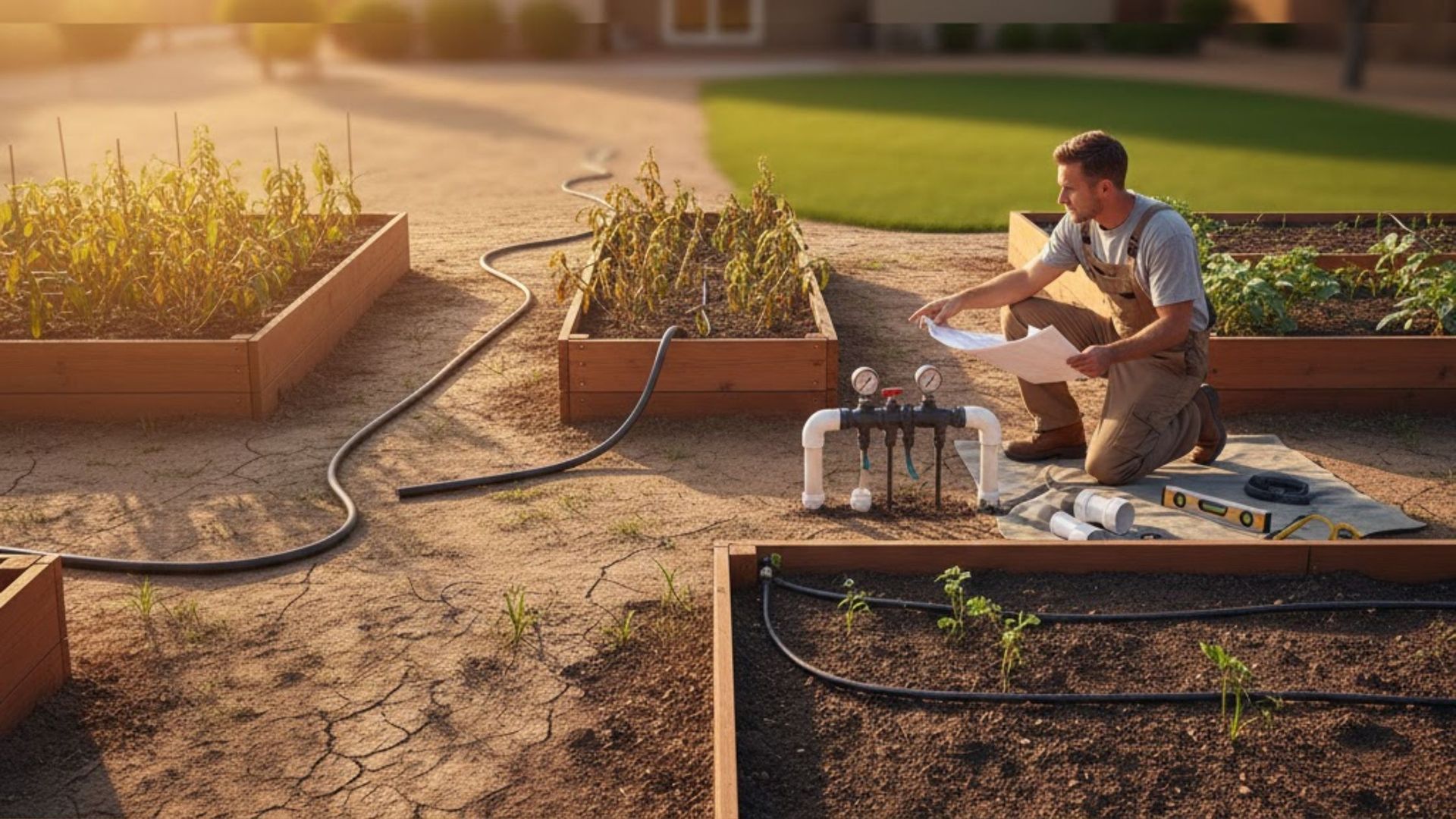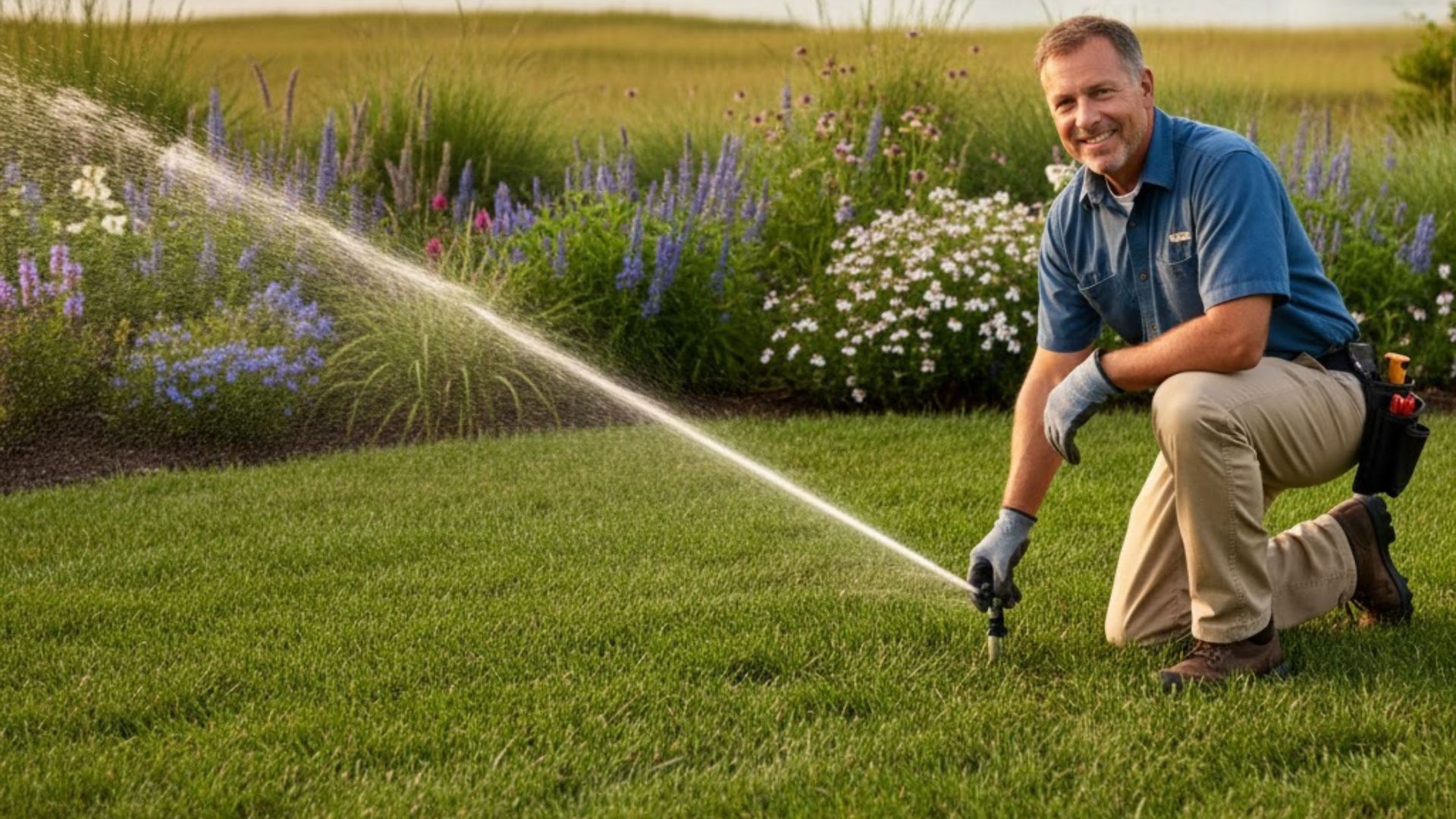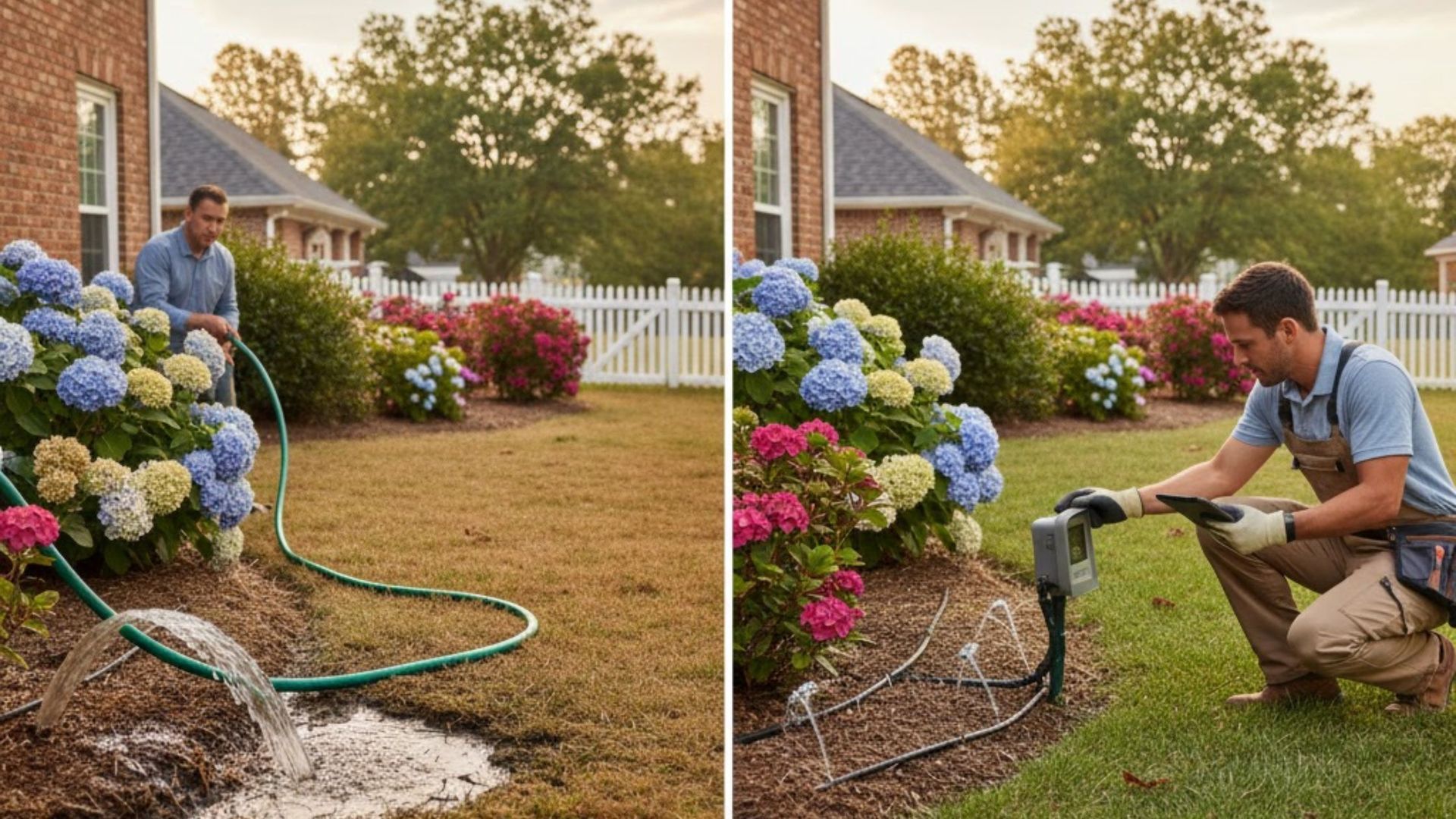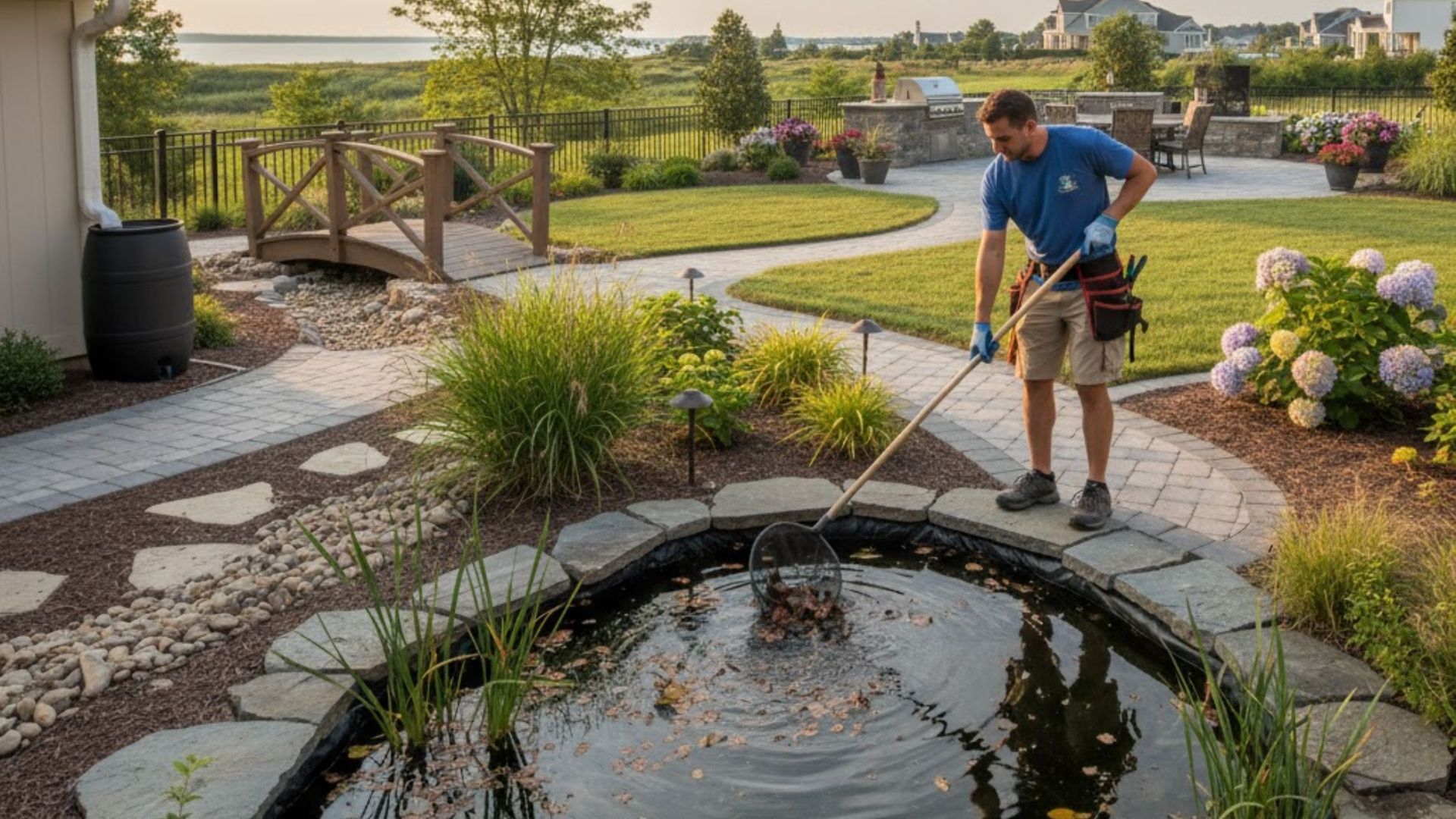How Regular Yard and Water System Maintenance Prevents Costly Repairs in Hampton Roads Homes
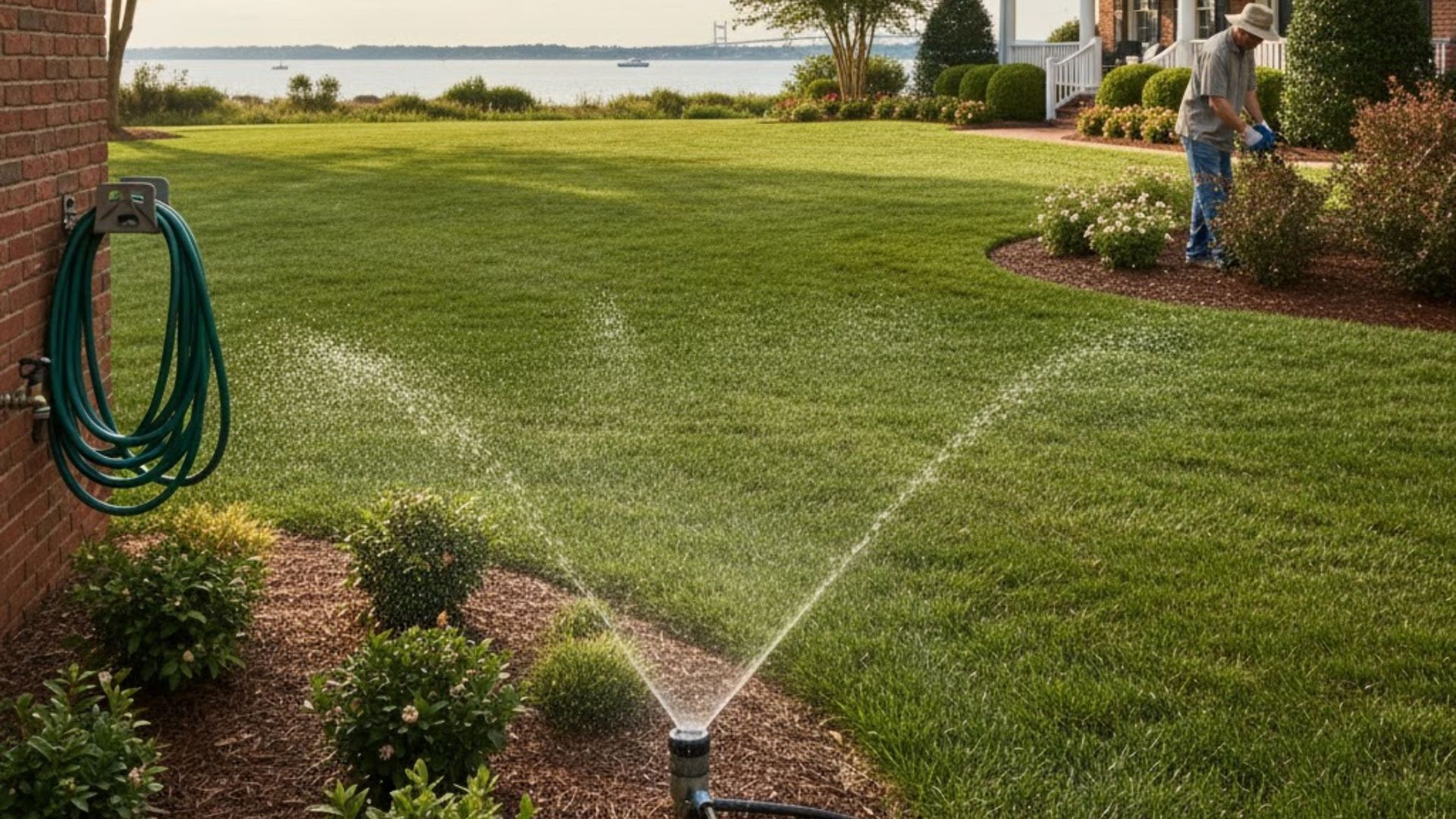
Living in the beautiful coastal region of Hampton Roads, Virginia, offers many benefits, but the area's climate—with its heavy seasonal rains, high water table, and proximity to the Atlantic Ocean—creates specific vulnerabilities for residential properties. The single most effective strategy for preventing devastating and expensive repairs to your home’s structure and utility systems is establishing a proactive, year-round maintenance plan focusing on managing water both inside and outside the house. This comprehensive approach, best handled by specialized Landscape Handyman Water Services professionals, ensures that minor issues are caught and corrected before they escalate into major problems like foundation damage, mold, or burst pipes, which can easily cost tens of thousands of dollars to fix. Regular inspection of your irrigation, drainage, and utility connections provides peace of mind and, crucially, preserves the long-term value and structural integrity of your home.
Why is Water Pooling Near My Foundation Such a Major Concern in Hampton Roads?
Water pooling near your foundation is perhaps the most serious sign of neglect in a home’s exterior management system, particularly in the Hampton Roads area where the soil often has high clay content and high natural moisture levels. This standing water signals that your property’s essential drainage systems are failing, leading to severe consequences from hydrostatic pressure. When the ground around your concrete foundation becomes saturated, it expands and exerts tremendous lateral force against the basement or crawl space walls, a pressure that concrete is not designed to withstand. This relentless pressure leads to bowing, cracking, and eventual structural failure, a repair process that is immensely costly and invasive to the entire property.
The danger of excess moisture goes beyond physical pressure; it also promotes an environment ripe for pest infestations and mold development within crawl spaces and basements. Virginia's humidity, combined with poor under-house ventilation caused by water intrusion, creates the perfect breeding ground for fungi and wood-destroying insects like termites. The repair often requires professional water mitigation, structural stabilization, and the installation of complex waterproofing solutions, making the initial expense of simple drainage correction a sound investment. Furthermore, during winter months, this saturated soil can be subjected to frost heave, where water freezes and expands, intensifying the stress on foundation walls and accelerating the rate of damage significantly.
The Hidden Threat: Moisture and Foundation Stability
The fluctuation of moisture levels in the soil is the primary mechanism by which foundation damage occurs across the mid-Atlantic region. It is a critical factor that many homeowners overlook, focusing only on the visible damage after it has occurred.
- Hydrostatic Pressure: This is the force created by standing water pushing against a submerged or partially submerged surface. In the context of a home, this means saturated soil relentlessly pushing against your foundation walls. If water cannot drain away quickly, this pressure builds up, often causing cracks that allow water to seep directly into the home.
- Soil Shrinkage: Conversely, prolonged periods of drought or dry weather in the summer, especially with aggressive tree and shrub root systems pulling moisture away from the house, can cause the clay-heavy soil to shrink dramatically. This shrinkage pulls support away from the foundation footing, leading to differential settlement, where the house sinks unevenly.
- Mitigation: The key to stability is consistency. The ground surrounding your foundation needs consistent, moderate moisture levels—not saturated, but not bone-dry either. This balance is achieved through controlled watering via irrigation and highly effective yard drainage solutions.
Grading and Ground Slope: Your First Line of Defense
Before any elaborate drainage system can be installed, the fundamental grading of your yard must be correct. This simple, yet crucial, element is often neglected as the ground settles over time or is improperly set during initial construction.
- The Golden Rule of Slope: Experts recommend that the grade of the soil should slope away from the foundation at a minimum rate of six inches over the first ten feet. This ensures that rainwater and melting snow are immediately directed away from the structural perimeter of the house.
- Checking the Slope: Homeowners can easily check this using a long level and measuring tape. If the grading is negative—meaning the ground slopes toward the house—it creates a catch basin that channels every drop of rain toward the foundation walls, virtually guaranteeing eventual water intrusion.
- Regrading as a Solution: When grading issues are identified, simple regrading using compacted, low-permeability soil can solve a massive potential problem. This work is essential before laying sod or installing flowerbeds, as these additions can inadvertently alter the critical grade if not planned correctly.
Elevating Efficiency with Focused Water System Attention
Regular, focused attention on your outdoor watering systems is a non-negotiable step in property management. An efficient, well-maintained system conserves water, keeps your landscape healthy, and protects your home from over-saturation issues. This is a primary function of professional Landscape Handyman Water Services providers who specialize in the complexities of residential irrigation and landscape water management.
Immediately following a major winter storm or before the onset of the summer heat, having a specialist inspect and tune your system is vital. This is why the comprehensive service package offered by a Landscape Handyman Water Services firm is so important. These professionals do more than just fix broken parts; they calibrate the entire system to match the specific micro-climates and soil conditions of your property. They ensure every zone is applying water efficiently, which not only saves you money on utility bills but also prevents the creation of wet spots near the foundation.
Spring Start-Up: Waking the System
The annual system start-up, often called summerization or irrigation maintenance Hampton Roads, is the single most important appointment for ensuring a functional season. After being dormant and drained for the winter, every component needs a thorough check.
- System Inspection: This involves turning the main water supply back on slowly and checking the pressure for any leaks in the main line, which may have been damaged by ground shifting during the colder months.
- Head Adjustment and Replacement: Sprinkler heads often get knocked out of alignment by lawnmowers, foot traffic, or settling soil. Misaligned heads spray water onto sidewalks, driveways, or directly onto the house siding, wasting water and potentially causing damage to hardscapes and wood. Any broken, missing, or heavily clogged heads should be replaced immediately to ensure even coverage across the landscape.
- Controller Programming: The system controller, the "brain" of your setup, must be reprogrammed for the new season's schedule, ensuring watering times align with local regulations and the changing needs of the landscape as temperatures rise.
Summer Monitoring and Calibration
Once the system is running, the maintenance becomes focused on optimization and responsiveness to Virginia's summer conditions. This is where the true efficiency of your water system is realized or lost.
- Deep, Infrequent Watering: Homeowners should transition from short, daily watering cycles to deeper, less frequent irrigation. This encourages grass and plant root systems to grow deeper into the soil, making them more resilient to drought and high temperatures. Watering early in the morning minimizes evaporation and reduces the risk of fungal growth.
- The Can Test: Calibration is the process of measuring exactly how much water your system applies in a given time. By placing small, straight-sided containers across a zone and running the system for a set time (e.g., 15 minutes), you can calculate the application rate. This prevents overwatering, which contributes to soggy spots, or underwatering, which leads to parched, vulnerable turf.
- Smart Technology: Upgrading to a smart irrigation controller allows the system to automatically adjust watering schedules based on real-time weather data, including rainfall, temperature, and humidity. This level of optimization is an incredibly powerful tool for water conservation and maintaining ideal soil moisture levels around your property. HR Irrigation specializes in installing and integrating these advanced technologies, offering homeowners total control and maximizing water efficiency throughout the growing season.
Fall Shutdown: Protecting Against Winter Damage
The process of winterization, or the fall shutdown, is absolutely critical for property protection, as water left in the pipes during freezing temperatures can cause lines to crack, leading to massive leaks when the system is reactivated in the spring.
- System Draining and Blowing Out: The most essential step is clearing all water from the pipes, valves, and sprinkler heads. For buried systems, this is typically done using an air compressor to blow out the lines, ensuring no standing water remains to freeze.
- Backflow Device Care: The backflow preventer, which is essential for protecting your potable water supply from irrigation system contaminants, must also be properly drained and insulated or removed for the winter. Ignoring this can result in damage to a costly component.
- Pre-Winter Inspection: The fall is also an ideal time for a professional to assess any needed repairs—like replacing an aging valve or adjusting buried pipes—while the ground is still workable, allowing for a seamless, functional start in the following spring.
Protecting Your Property with Robust Yard Drainage Upkeep Hampton Roads Solutions
In a low-lying, high-moisture environment like Hampton Roads, relying solely on natural grading is often insufficient. Proactive yard drainage upkeep Hampton Roads is vital because persistent standing water can damage your landscape, erode topsoil, kill grass and plants, and, most critically, threaten the very foundation of your house. Effective water management requires understanding where water collects and installing targeted solutions to divert it safely away from the home and neighboring properties.
Proper management of surface and subsurface water is a necessity for every property owner here. The combination of high water tables near the coast and the common use of dense clay soil means that water does not easily percolate into the ground. When rain falls, it must be collected and moved, or it will sit, leading to saturated, unstable ground. This is where advanced solutions such as French drains and catch basins become indispensable tools in securing your property against water intrusion and preventing costly water damage restoration services down the line.
Diagnosing Common Water Pooling Issues
Before implementing any solution, a thorough professional diagnosis is necessary to understand the root cause of the standing water. Different issues require different corrective measures.
- Gutter and Downspout Overflow: This is the most frequent cause of localized pooling near the house. If gutters are clogged with leaves and debris, water cascades directly down the wall and saturates the immediate foundation area, often undermining sidewalks and patios.
- Improper Grading: As discussed, if the ground slopes toward the house, water is naturally directed inward. This is often visible as soft, perpetually damp spots right next to the house structure.
- Perched Water Tables: In coastal areas, a layer of impermeable soil beneath the surface can trap water, creating a "perched" water table that sits close to the surface, leading to widespread soggy areas that never fully dry out after a rain.
Engineered Drainage Solutions: French Drains and Catch Basins
For areas with persistent pooling or heavy water flow, engineered solutions provide the only reliable method for control. These systems actively capture and redirect water through underground piping.
- French Drains: These are subsurface drainage systems designed to intercept and move groundwater and surface water away from vulnerable areas. A traditional French drain consists of a trench filled with gravel, a perforated pipe wrapped in filter fabric, and a permeable cover layer. The water flows into the pipe, which maintains a slight slope, channeling the water to a safe exit point, such as a street drain or a designated drainage swale.
- Catch Basins: A catch basin, or area drain, is a surface-level collection point, typically a grate, designed to collect significant volumes of surface runoff. It includes a small underground chamber that traps debris and silt before the water flows into a connected pipe. These are ideal for collecting water in low-lying depressions in the lawn or at the base of paved areas like driveways.
For homeowners exploring these long-term protection measures, a consultation with HR Irrigation is the first step toward a dry and secure home.
Managing Roof Runoff: Downspout Extensions
The sheer volume of water that runs off a roof during a rain event is often underestimated, but it is a massive contributor to foundation problems. A standard 1,500-square-foot roof can shed over 900 gallons of water during just a one-inch rainstorm.
- The Danger of Short Spouts: Most builders install downspouts that discharge water immediately next to the foundation. This concentrates a massive amount of water directly into the soil closest to the house, which can quickly overwhelm the soil and create hydrostatic pressure.
- The Solution: Downspout extensions are a simple, yet highly effective solution. These extensions can be above or below ground, but they must carry the collected roof water at least three to five feet away from the foundation. For the best long-term solution, downspouts should be connected to a buried, closed-pipe system that channels the water into the larger yard drainage infrastructure, preventing surface erosion.
We have a long track record of successful projects, which you can see by checking Our reviews.
The Landscape Handyman Water Services Approach to System Integrity
The term Landscape Handyman Water Services describes a specialization that recognizes the critical relationship between your outdoor environment and your home’s internal systems. This is about integrating the exterior maintenance—the grading, irrigation, and drainage—with the health of the internal plumbing, lines, and crawl spaces. By treating the yard and the house as one interconnected system, we can prevent damage that crosses this boundary.
When you invest in consistent maintenance, you are not simply hiring a technician; you are securing an expert who manages your property's vulnerability profile. This includes services that are often neglected but can lead to catastrophic damage, such as line inspections and backflow testing. Regular care by a specialized provider ensures that all components, from the subterranean water pipes to the critical water-shedding capabilities of your roof system, are in optimal working order.
The Silent Leaks: Water Lines and Sewer Pipes
Below the surface of your beautiful Hampton Roads lawn lie the utilities that deliver fresh water and carry away waste—lines that are constantly subject to shifting soil, root intrusion, and general corrosion. Leaks in these underground lines are often called "silent leaks" because they can go unnoticed for weeks or months, causing significant damage before any symptoms appear inside the home.
- Water Line Issues: Small leaks in the main water supply line can lead to dramatically high water bills and, more concerningly, cause the continuous saturation and erosion of the soil around the pipe. Over time, this erosion can create a void under the foundation or driveway, leading to instability and eventual collapse of the hardscape.
- Sewer Line Issues: A small crack or intrusion by a tree root in the sewer line can be a slow-motion disaster. While it may start with slow drains or gurgling sounds, a significant failure can back up raw sewage into the home, which is a major health hazard requiring extensive and costly remediation. Regular inspection, often using small cameras, is the only way to proactively catch these issues.
Water Heater Longevity in the Coastal Climate
While often seen as an indoor appliance, the water heater’s lifespan and performance are tied to the water quality and plumbing health of the entire home system. In the Hampton Roads area, water often carries minerals that can accelerate corrosion and sediment buildup within the tank.
- Sediment Buildup: As water is heated, minerals settle at the bottom of the tank, creating a layer of sediment. This layer reduces the water heater's efficiency, forcing it to work harder and increasing energy costs. Over time, this buildup can cause overheating and premature failure of the heating elements.
- Flushing the Tank: A critical maintenance step is the annual flushing of the water heater tank. This removes the accumulated sediment, restoring efficiency and significantly extending the lifespan of the unit, whether it is a traditional storage tank or a modern, energy-efficient tankless system. This simple procedure is a vital part of comprehensive home water services.
Backflow Prevention: A Critical Safety Check
The backflow preventer is a simple but life-saving device required on all residential irrigation systems to comply with public health standards. It is designed to ensure that dirty water from your irrigation system, which may contain fertilizers, pesticides, or other contaminants, cannot flow backward into your home’s potable drinking water supply or the public water system.
- Annual Testing Mandate: Because backflow preventers have internal check valves that can fail due to wear, debris, or freezing, they are legally required to be tested annually by a certified technician. This test confirms the device is functioning properly to protect the municipal water supply from contamination.
- Ignoring the Test: Neglecting the annual test not only puts your family and neighborhood at risk but also results in non-compliance with local ordinances, which can lead to fines or the mandatory shut-off of your irrigation water supply. This small component is a massive element of water safety.
We encourage you to reach out to Contact us today to schedule a comprehensive property assessment and discuss how our customized service plans can save you money and protect your property’s integrity.
Establishing Seasonal Yard Care Rhythms in Hampton Roads
Effective structural preservation requires more than just reacting to problems; it demands a predictable, seasonal rhythm of exterior care, sometimes referred to as seasonal yard care Hampton Roads. This means adjusting your landscaping and maintenance practices to complement the unique climate cycle of Virginia. By anticipating the environmental stressors of each season—the heavy moisture of spring, the intense heat of summer, and the ground-shifting potential of winter—you ensure your home is always prepared.
This holistic approach includes monitoring the entire envelope of your home, from the roof's ability to shed water to the placement of every plant and shrub near the foundation. The goal is to create a dry zone immediately surrounding the structure, ensuring that water is always moved away, and moisture fluctuations in the soil are minimized to maintain stability. A well-planned, strategically executed maintenance schedule is the difference between a secure property and one vulnerable to the region’s intense weather patterns.
The Importance of Soil Health and Plant Placement
The living elements of your landscape play a significant role in managing water and protecting your home's foundation. Thoughtful planning about what you plant and where you plant it can be a powerful tool for water management.
- Aggressive Roots: Large trees and shrubs with invasive root systems, such as silver maples or certain fast-growing evergreens, are constantly seeking moisture. If they are planted too close to the foundation, their roots can draw excessive water away during dry periods, causing the soil to shrink and the house to settle. They can also exert direct pressure on underground pipes and foundation walls as they grow.
- The Safe Zone: As a rule of thumb, large trees should be planted at a distance equal to at least half of their estimated mature height from the foundation. Smaller shrubs should be kept at least three feet away. This preserves the necessary soil moisture balance near the structure.
- Groundcovers and Erosion Control: For slopes or bare areas vulnerable to soil erosion, planting groundcovers is a cost-effective strategy. These plants bind the topsoil with their roots, preventing heavy rain runoff from carrying away precious topsoil and potentially exposing underground pipes or utility lines.
The Role of Mulch and Groundcover
Mulch is not just a decorative element; it is a vital tool in water management and soil health when used correctly. Its primary purpose is to moderate soil temperature and moisture.
- Moisture Regulation: A consistent layer of organic mulch (pine straw, wood chips) that is two to four inches thick helps retain moisture during dry spells, preventing the rapid desiccation and shrinkage of the soil around the foundation. This creates the stability necessary for structural integrity.
- Avoiding Pests and Rot: Crucially, mulch should never be piled directly against the wood siding, vents, or trim of the house. A small gap should always be left to ensure these areas stay dry. Piling mulch directly against the structure traps moisture, inviting wood rot and providing a perfect, moist highway for pests like subterranean termites to access the structure.
- Aesthetics and Function: Groundcovers and strategically placed decorative rock or gravel can be used immediately adjacent to the foundation to ensure that the soil remains dry while still providing an attractive, finished look to the landscaping beds.
The Value of Professional Service and Expertise
While many aspects of home maintenance are suitable for do-it-yourself efforts, the critical systems involving water and structural integrity require specialized knowledge, equipment, and a deep understanding of local environmental factors. This is especially true in the unique geography and climate of Hampton Roads, which includes the cities of Virginia Beach, Chesapeake, Norfolk, Newport News, Williamsburg, and Portsmouth.
A professional service, like those offered by HR Irrigation, provides more than just repairs; they provide preventative maintenance, expert diagnostics, and peace of mind. Their expertise ensures that the solutions implemented are tailored not just to your property, but to the specific challenges presented by coastal Virginia, such as managing high water tables, coordinating with local codes for backflow prevention, and choosing materials best suited to withstand seasonal weather shifts.
When to Call the Experts
Knowing when to transition from simple homeowner maintenance to professional intervention can save thousands of dollars and protect your property from long-term damage.
- Foundation Concerns: Any signs of new cracks in drywall, sticking doors or windows, or obvious settlement cracks in exterior brick or concrete are emergency signals that require immediate professional foundation and water management inspection.
- Persistent Wet Spots: If a section of your lawn remains soggy for more than 48 hours after heavy rain, it indicates a significant failure in grading or the drainage system that requires engineered correction, such as the installation of a French drain or swale.
- Water Bill Spikes: A sudden, unexplained jump in your monthly water bill is the most common indicator of a hidden leak in a water line, irrigation pipe, or a constantly running toilet. A professional can quickly perform a leak detection test and isolate the source of the problem.
- System Failure: If your irrigation system fails to turn on, a zone stops working, or you notice a geyser of water, professional repair is necessary. Working with complex valves, controllers, and electrical components requires a licensed and insured technician to prevent further system damage or electrical hazards.
Why Local Experience Matters
The local environment of Southeastern Virginia presents variables that a generalized national contractor might miss. The knowledge of where utility lines are commonly buried, the composition of the native soil, and the patterns of heavy rainfall are specialized details that local experts possess.
- Compliance and Codes: Local service providers are experts in navigating the specific permitting and code requirements for backflow testing and drainage solutions unique to the municipalities across Hampton Roads. This ensures that any work done on your property is safe, legal, and compliant with all public health standards.
- Material Selection: They understand which irrigation pipes, drainage materials, and landscape treatments are best suited to resist the clay soil, saline air, and persistent moisture of the coastal environment, ensuring the longevity and reliability of your installed systems.
The best way to secure your home against the expensive disasters caused by water intrusion is through comprehensive, proactive maintenance. Engaging a trusted provider of Landscape Handyman Water Services ensures that the critical link between your yard and your home’s structure is never compromised. We pride ourselves on offering this vital protective service throughout the region.
Frequently Asked Questions (FAQs)
This section answers common questions homeowners have about maintaining water systems and drainage in the Hampton Roads area.
How often should I check my irrigation system for leaks?
You should visually inspect your irrigation system for leaks, broken sprinkler heads, or overspray at least once per month during the active watering season (typically April through October). Additionally, an expert should perform a comprehensive inspection and system pressure test twice per year: once during the spring startup and again during a mid-summer check-up, especially during extended periods of heat, to ensure peak efficiency.
What is the minimum required slope for proper yard grading near a home?
The generally accepted professional standard is that the soil should slope away from the home's foundation at a minimum grade of six inches over the first ten feet. This necessary slope ensures that surface water runoff from rain or irrigation is directed away from the foundation walls, significantly reducing the potential for hydrostatic pressure buildup and foundation damage.
What happens if I neglect backflow preventer testing?
Neglecting the annual backflow preventer test creates a serious health risk, as the device may fail without notice, allowing contaminants from your irrigation system (such as treated water, fertilizers, and pet waste) to enter your drinking water supply. Furthermore, local municipalities across Hampton Roads enforce strict compliance, and failure to provide current certification can result in fines or the city ordering the disconnection of your irrigation system from the public water source.
Can poor drainage cause damage to my driveway or walkways?
Yes, poor drainage is a common cause of costly damage to paved surfaces, including driveways, sidewalks, and patios. When water pools on or around these hardscapes, it can seep into the base layer beneath the concrete or asphalt. If this base layer becomes saturated and then freezes during cold weather, the resulting expansion (frost heave) will lift and crack the paved surface. Persistent erosion from uncontrolled water runoff can also undermine the edges of the pavement, causing it to settle and break away.
What are the key differences between a French drain and a catch basin?
The key difference lies in the type of water they primarily manage. A catch basin is a surface collection system, identifiable by its grated opening, designed to collect large volumes of standing surface water in low spots, like puddles. A French drain is a subsurface system, consisting of a perforated pipe buried in a trench surrounded by gravel, and is primarily designed to manage groundwater or water seeping through the soil before it reaches the surface or the foundation. Catch basins are best for localized, heavy runoff, while French drains are ideal for persistent soggy ground and foundation protection.
Conclusion: Securing Your Home with Proactive Care
The complex environmental factors of the Hampton Roads area—from fluctuating water tables to heavy seasonal storms—make proactive home maintenance an essential investment, not an option. By integrating diligent seasonal yard care Hampton Roads with expert management of your water systems, you actively defend your property against the pervasive threat of water intrusion, erosion, and structural damage. The greatest returns are not just measured in reduced utility bills, but in the long-term protection of your foundation and the overall health of your home. Choosing comprehensive Landscape Handyman Water Services is choosing financial security. For total peace of mind and to schedule your full system audit and preventive maintenance plan, please reach out to the dedicated team at HR Irrigation today.
